Vintage Equipment aka Boat Anchors
I have always been fascinated by old amateur radio equipment. I'm not exactly sure what the fascination is. Perhaps it is the fact that, unlike modern equipment, I can still get in there with a soldering iron and make my own repairs. Certainly it allows me to take a step back in time where radio and communication technology used vacuum tubes and there were no solid state devices. Maybe it is just revisiting my youth - but whatever, I enjoy tinkering with my vintage equipment. Vintage radios are called 'boat anchors' by the amateur radio community. This is because, for the most part, they are large and heavy. It also used to be a rude term for the equipment because it had outlived it's usefulness and had been replaced by newer or better equipment; hence, it was only useful as a boat anchor. However, many of these vintage pieces of ham gear have become quite collectable. Today, having a boat anchor station is something to be proud of.
Work Bench
Most of my vintage radio equipment came to me because they stopped working for the owner. I am lucky to have a pretty complete arsenal of test equipment and the knowledge to use them. Here you can see my work bench. I just finished repairing and calibrating an EF Johnson VFO that will go with its companion EF Johnson Viking II transmitter. This Viking II is not the same one that is in a my operating station (see later picture). This Viking II has only been partly restored to operating condition. It is awaiting some capacitors from Canada and the speech amplifier and audio driver stage will be rebuilt.
The nice thing about vintage gear is they are considerably easier to work on than newer equipment. Today's solid-state equipment is very compact, miniaturized, and may require special test fixtures or equipment. Todays amateur gear will almost always have surface mount devices (SMDs) that are very difficult to test and replace. In addition to having a workbench devoted to vintage gear, I also have some limited SMD soldering and desoldering capabilities. But I try not to use it, unless I absolutely need to.
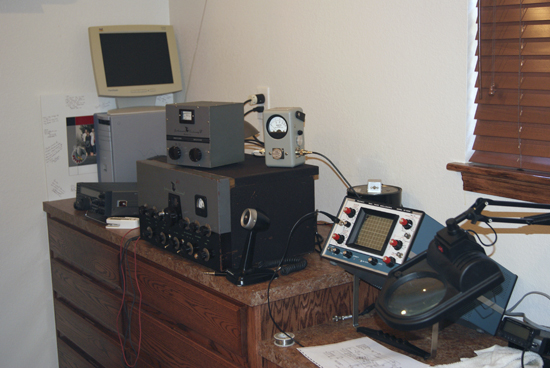
Work Bench The EF Johnson VFO and its companion transmitter, a Viking II.
A Real Boat Anchor
One of my recent acquisitions was a Heathkit Apache transmitter. This behemoth weighs in at 95 pounds and produces 120 Watts in CW and slightly less in AM. While it has a nickname the 'Scratchy Apache' for it characteristic scratchy audio on AM, I have modified mine to provide a more pleasing audio response. Produced as a kit, it was not cheap. In 2011 dollars, the Apache went for about $2,500.
This particular Apache is in very good condition, both electrically and cosmetically. Everyone who sees it always comments on the chrome knobs.
This transmitter has undergone extensive restoration. Many of the tubes, capacitors, and resistors have been replaced. Even new stainless Allen socket screws for the front panel were obtained to give it a 'like new' look. The built in VFO has been repaired and calibrated. This transmitter has probably 25-30 hours of my time invested in it bringing it back to a 'like new' condition. While I have tested this transmitter, I am awaiting some filter capacitors before I will put this unit on the air for any extended periods of time.
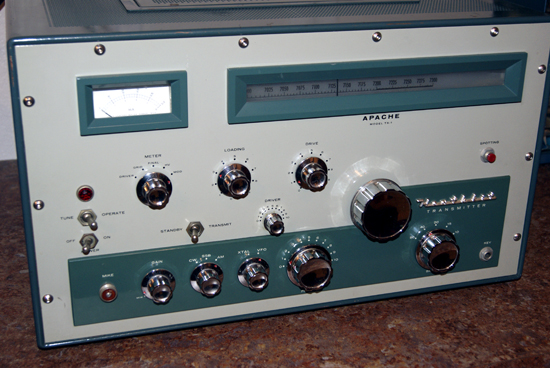
Heathkit Apache Transmitter Still undergoing restoration.
Vintage Can Be Compact - Sold to Mike - W5TMO
While in general most vintage gear is large and heavy, there are always exceptions to the rule. This is an example of a single sideband (SSB), AM, and CW transceiver that was built in 1968. In fact, this one was built in October of 1968.
When I obtained this unit the first thing I noticed was how exceptionally clean the face and cabinet were. The inside is just as pristine. Obviously it was owned by hams who were careful with their equipment. The previous owner reported it would not transmit. The problem turned out to be a bad diode and resistor in the power supply circuit that powers the transmit relay.
I use this particular radio almost daily to check into a 40 meter SSB net. It puts out almost 400 Watts of very nice sounding SSB audio. While I had this unit it always got rave reviews on the transmitt audio. Another advantage in vintage gear. Sometimes they can be purchased for almost nothing. Of course there is always the risk that the repairs can be costly. Including the microphone and replacement parts I only have about $100 invested in this beautiful transceiver (But I have over $200 invested in its power supply).
In general I try to keep my vintage gear as original as possible. However, I'm not opposed to making modifications that improve functionality and operation. Recently I added a digital display for my Swan. To see a discussion of the Swan Digital Display and the frequency stability I've achieved with my Swan click here.
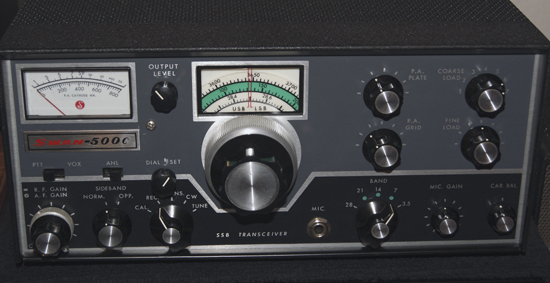
Swan Transceiver My beautiful Swan 500C is in operation almost daily.

Swan Digital Display The digital display (at right) reads the operating frequency just like a modern radio does.
My 1950s Station
Take a step back to the middle of the 1950s. May 14, 1956, to be exact (the date of my first license). This is what a beginning amateur would have aspired to own and operate in those days.
The receiver is a Collins 75A4, unquestionably one of the finest receivers for that time period. My 75A4, built in 1957, has been kept in 'like new' condition and has the matching speaker. When built it underwent a checkout and an 8 hour 'burn-in'. The test sheet was attached to the operating manual which has alignment instructions that I still use when it needs work.
The transmitter is an EF Johnson Viking II. It would have likely been selected because television interference (TVI) was a large problem in that day and age. The Viking II was the first commercially made transmitter that advertised TVI suppression as part of it's design. With a copper plated cabinet and extensive filtering and suppression, a Viking II was indeed a very good transmitter. I have two of these transmitters, but have owned four over my lifetime. I consider the Viking II to be one of the best designed and engineered transmitters of its era. It could be purchased factory wired or as a kit between 1952 until 1957.It weighs 65 pounds and its output is 100 Watts on AM or 130 Watts on CW.
Finally, while many aspiring hams used piezoelectric crystals to define their operating frequency, the 'truly advanced amateur' would obtain a variable frequency oscillator (VFO) and incorporate it into his or her station.
This is my vintage station of which I'm quite proud. While I'm currently using the restored Heathkit VFO (center of the picture), I intend to modify one of my Johnson VFOs to match the grid block keying that is presently incorporated in my Viking II. That way I can operate CW in a semi-break-in mode.
The microphone is an Astatic D-104, also vintage to the mid-1950s era.
Another aspect of vintage gear is the allure of vacuum tubes. I've tried to capture that nostalgia with the final picture. To see a larger picture of the tubes glowing click here.
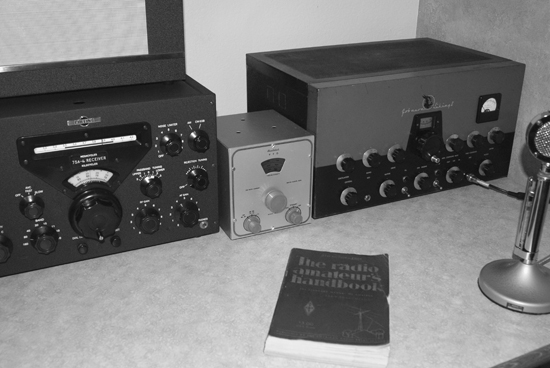
W5GW Vintage Station I couldn't resist, this had to be a black and white photo - note the 1954 ARRL Handbook - I devoured practically every page in this book.
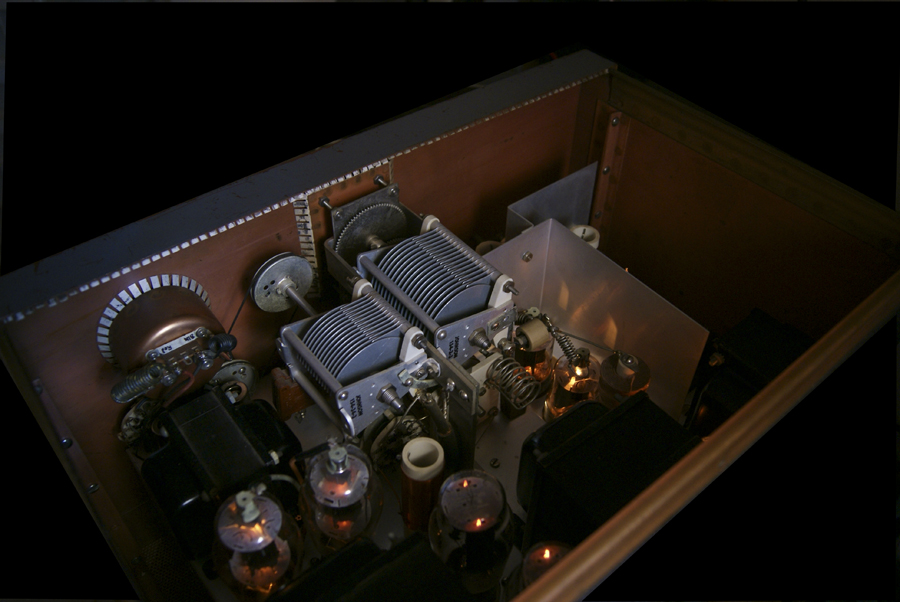
Tube Glow The inside of my Viking II illuminated by the filaments of the vacuum tubes.